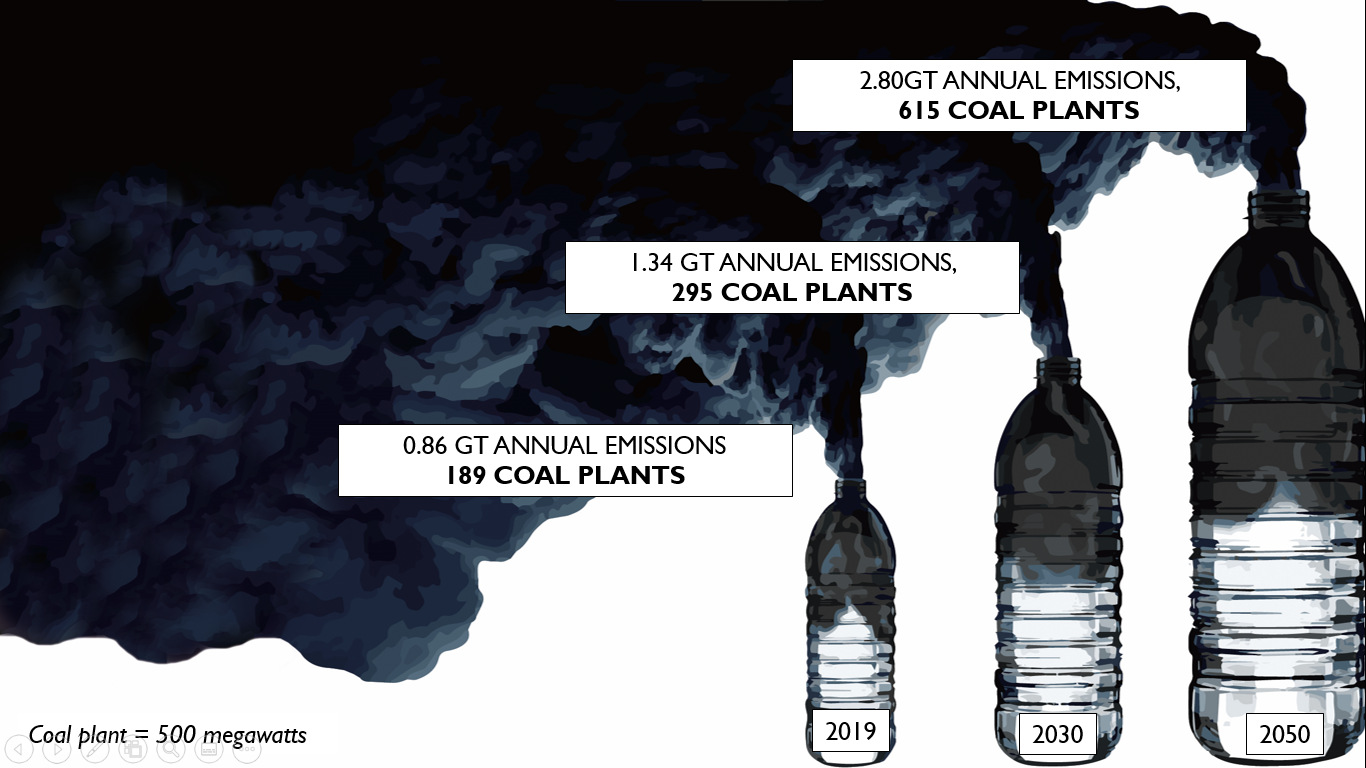
The plastics crisis is a climate crisis. Greenhouse gases (GHGs) are emitted throughout the plastic life cycle and this threatens our ability to keep global temperature rise below 1.5°C. Extraction, refining and manufacture of plastics are all carbon intensive activities.
The plastics industry is the fastest-growing source of industrial greenhouse gases in the world. The UN Environment Programme estimates that the greenhouse gas emissions from plastic production, use and disposal could account for 15 percent of the total global carbon budget by 2050, making it hard to meet global targets without cutting emissions elsewhere.
Emissions from petrochemicals have doubled in the past 25 years due largely to growth in demand for plastic and fertilizers, according to a report by Frederic Bauer of Lund University in 2022, and a new report by Bauer found that countries with large fossil fuel reserves are investing in the expansion of fossil-fuel based petrochemical production. While governments are committing to action on climate change and have signed up to initiatives tackling global plastic pollution, massive investments are being made to expand the production capacity of the petrochemical sector. Saudi Arabia, China and the United States, for example, have NOT signed the Global Plastics Treaty, which would create a legally binding agreement on plastic reduction goals.
What does expanding production capacity for petrochemicals mean for oil and gas companies? For the oil and gas industry, the plastic production pipeline is its future business model in a world where energy is transitioning to renewable sources. This fact explains the oil and gas industry’s unrivaled investments in public relations and misinformation campaigns about recycling and the plastic reduction lifestyle.
 Figure 1: Global plastic production since 1950. Source: P. Ryan, 2015.
Figure 1: Global plastic production since 1950. Source: P. Ryan, 2015. Figure 2: Estimated annual emissions from the plastics lifecycle by 2050 (CIEL, 2019).
Figure 2: Estimated annual emissions from the plastics lifecycle by 2050 (CIEL, 2019).Although cheaper to produce, virgin plastic production contributes indirectly to climate change because it requires energy to mine, extract, harvest, process and transport raw materials; more energy to manufacture, transport and dispose of waste products.
Only between 9 to10 percent of plastic is recycled globally. About 79 percent of plastic waste ends up in landfills or nature and some 12 percent is incinerated. Each year, vast amounts of plastic waste is exported to low-income countries where it accumulates in landfills, pollutes water and air, degrades ecosystems and harms human health.
a. Incineration Releases GHGs
Incineration of plastic waste releases significant GHG into the atmosphere, alongside toxic pollutants. Other disposal methods, including recycling, also come with their share of GHG emissions. In 2019, plastic production and incineration resulted in greenhouse gas emissions that equaled the emissions from 189 five hundred-megawatt coal power plants.
b. Landfills emit GHG gases
The incineration of plastic waste produces carbon dioxide. A lifecycle analysis study found that 20 million tons of CO2 equivalent emissions were released from the disposal of one ton of solid waste on land (Gregory, 2010).
 Figure 3: The fundamental links between CO2 emissions and plastic pollution
Figure 3: The fundamental links between CO2 emissions and plastic pollutionc. Marine Litter may Accelerate Climate Change
A garbage truck equivalent of plastic waste is dumped in the ocean every minute. Plankton sequesters 30-50 percent of carbon dioxide emissions, but after it ingests microplastics, its ability to remove carbon dioxide from the atmosphere decreases. Plastic in the oceans may also interfere with the oceans’ capacity to absorb and sequester carbon dioxide.
Apart from climate impacts, plastic is bad for our health. It’s estimated that the average person could be injesting about five grams of plastic every week. A growing body of research points to the devastating health impacts along the entire plastic value change. The 2023 Minderoo-Monaco Commission on Plastics and Human Health reveals that:
Because the plastics crisis hurts people’s health, it is also a human rights crisis. While plastic pollutions hurts us all through microplastics, certain groups of people suffer additionally from other phases in the plastic lifecycle. Last year, the UN denounced environmental racism in the majority Black "Cancer Alley" region of Louisiana – an 85-mile stretch of land along the Mississippi River with more than 150 petrochemical plants and refineries. In Houston, Texas, scientists using remote satellite imagery have shown that poor air quality from industry is unevenly distributed among low-income, non-white and Hispanic neighborhoods.
The U.S. government fails to address the wide range of impacts along the entire plastic life cycle and downplays the role fossil fuel and petrochemical industries play in creating inequities. Countries must ban together to create legally binding rules that reduce plastic production (and therefore emissions) and must do so ambitiously while there is still a small window of opportunity to prevent irreversible climate disaster. So-called “solutions” perpetuated by the petrochemical industry dominate mainstream plastic narratives and confuse the public and policymakers. Strong regulations on the plastic waste trade, which has historically been done under the banner of plastic “recycling” are also needed to take undue burden off of Global South countries that are not responsible for the high levels of plastic consumption of the Global North.
At the same time, federal policy efforts like the Break Free from Plastic Pollution Act do not have the political will required to pass. Public awareness is lacking because plastic enjoys a positive image and is dominated by fossil fuel industry greenwashing and lobbying.
People over Plastic believes that greater awareness about plastic’s impact on people and the planet will lead to greater accountability and drives community-driven, targeted, innovative circular economy approaches that will solve the plastics crisis. At the same time, behavior changing consumer campaigns can help to reduce the demand for single use plastic.
Additional Reading